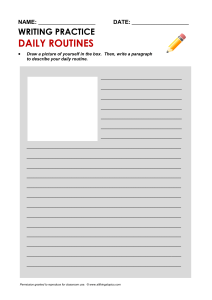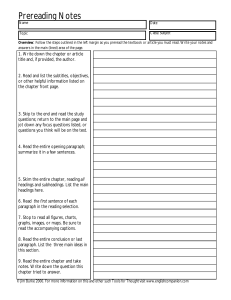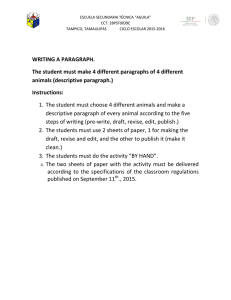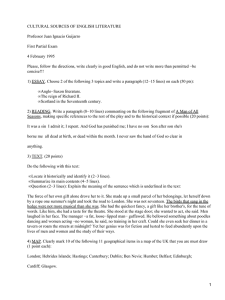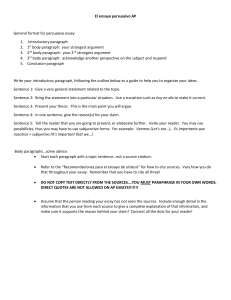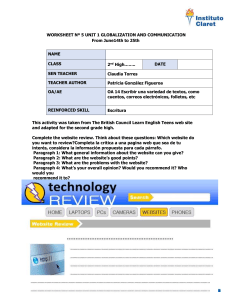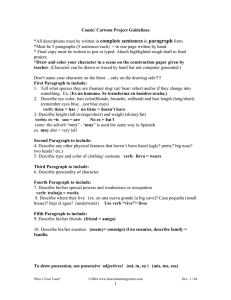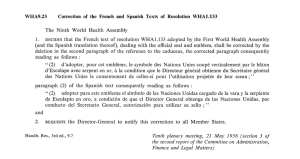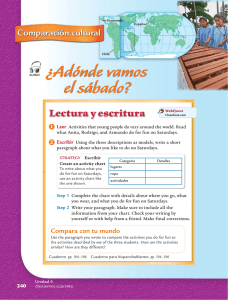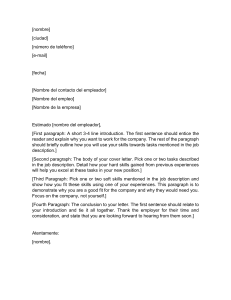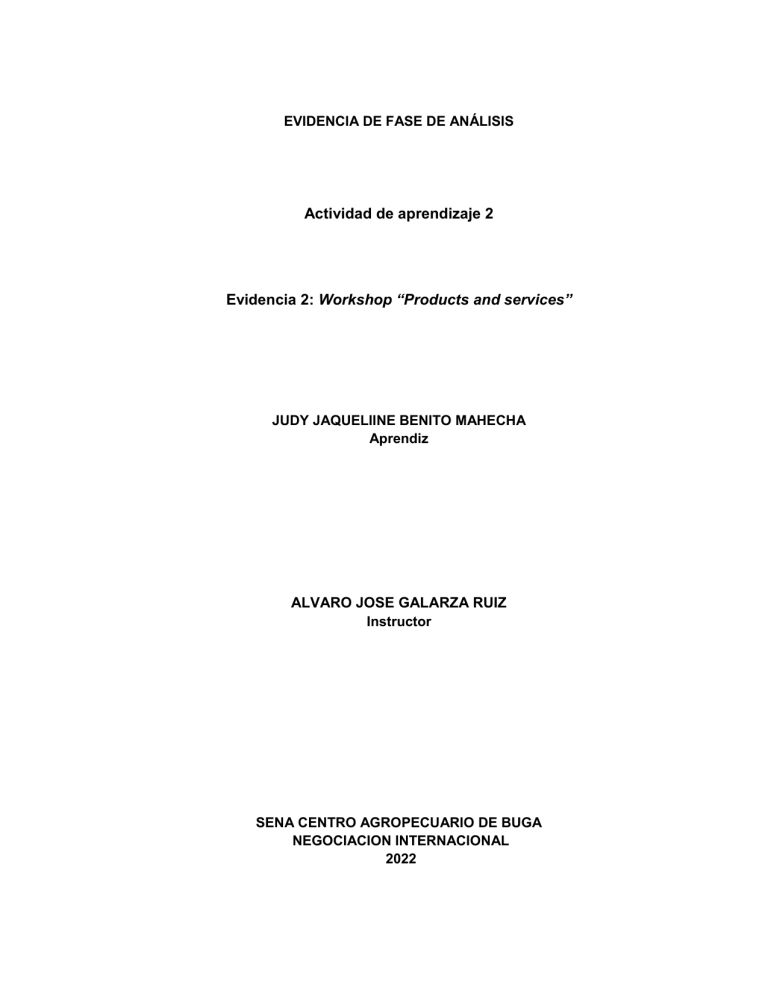
EVIDENCIA DE FASE DE ANÁLISIS Actividad de aprendizaje 2 Evidencia 2: Workshop “Products and services” JUDY JAQUELIINE BENITO MAHECHA Aprendiz ALVARO JOSE GALARZA RUIZ Instructor SENA CENTRO AGROPECUARIO DE BUGA NEGOCIACION INTERNACIONAL 2022 ➢ FIND THE MAIN IDEA OF PARAGRAPHS 1, 2, 9, 10, 11 AND 12, AND WRITE THEM IN A PARAGRAPH PARAGRAPH ONE Three factors combine to reshape the foundations of the modern economy. First, the digital revolution dramatically augments the reach, flexibility and agility of companies, big and small, creating new economic actors, such as ‘micro-multinationals’: technology-intensive companies that are born global. Second, international competition draws millions of new workers and consumers into what is increasingly a ‘race to the top’, rather than a ‘race to the bottom’, with emerging countries becoming champions of innovation, engineering ingenuity and skills acquisition. Third, cultural and structural trends change the nature of socio-economic interactions by transforming people’s aspirations and preferences, such as the expectation of instant gratification offered by one-click services or the seamless interoperability between products and electronic devices. PARAGRAPH TWO BLURRING LINES BETWEEN PRODUCTS AND SERVICES A pronounced distinction between product and service markets is fictitious: value creation and innovation increasingly take place at their intersection. Business-related services are often decisive in making products attractive to the consumer and they generate most of the value added in growth and employment. PARAGRAPH NINE THE DIGITAL CAR Cars have become computers on wheels. Software is revolutionizing the car industry, until recently one of the most traditional and hierarchically organized industries in the world. For example, Tesla – a company founded as recently as 2003 - has shown that there is no reason why a technology company cannot become a car company, with the design coming from California, modules being delivered by suppliers from around the world and the final product being put together in contract factories. Electronics and automation have become key components of the assembly line. PARAGRAPH TEN COMPETITION IN THE HIGHER VALUE-ADDED SEGMENT In spite of the slowdown of growth in emerging markets, the next decades are likely to be marked by a continued convergence process. As emerging countries move up the value chain, they increasingly rival producers and service suppliers from advanced economies. Instead of developing powerful industrial sectors locally, they can now leapfrog more advanced economies by adopting the latest technologies and sourcing products and services globally. As a result, OECD countries’ share in world manufacturing dropped from 82% in 1990 to 56% in 2013 (Figure 3, p. 4). Tellingly, China’s 12th Five-Year Plan for 2011-2015 explicitly shifts the focus to R&D and high-end manufacturing and services. This means that China and Europe will increasingly compete in the same markets, such as clean energy, aerospace, telecom equipment or broadband networks. Studies have shown that the complementarity of European and Chinese export offers has dropped from 85% in 2000 to 65% in 2010, which means that 35% of exports tended to overlap, compared to only 15% ten years earlier.5 Intensifying global competition means that competitive advantages are more fluid than they used to be, requiring dynamic approaches to competitiveness and productivity. PARAGRAPH ELEVEN BEHAVIORAL AND STRUCTURAL CHANGE The rationale of the emerging new economy is greatly influenced by ongoing cultural and structural shifts, some of which are induced by technology, while others result from broader societal trends. Their effect is profound, from the changing nature of work and its growing fluidity to the emergence of a sharing economy. In particular, the consumer and user perspectives – already central to current economic relations – will become dominant even in business-to-business transactions. Products are increasingly tailored to individual consumers’ needs and desires through processes such as ‘additive manufacturing’. Consumers will move from being objects of economic exchanges to active agents. This trend is already underway, as exemplified by the growing importance of ‘prosumers’. To illustrate, the energy system is shifting from a centralized, supply side approach to a demand-oriented model. New digital products and technologies are progressively modernizing the energy system by easing the way for a novel nexus between production, transportation, distribution and consumption. Increasingly, energy will become a service and not just a supplied commodity, providing new opportunities for energy service providers and aggregators, and giving life to new digital products, such as smart meters. These developments will transform the business model of energy utilities, bringing new, innovative and disruptive companies to the fore. These three factors – digitisation, globalization and socio-cultural transformations – combine to produce a more versatile, creative and interactive economy where value increasingly lies in the interoperability between products and services. Combining products and services has become the new normal as design, marketing, insurance and after-sale servicing are inseparable parts of the offering that the consumer demands and expects. As a result, manufacturing firms have incorporated strong service components into the way they operate while services firms have sought to benefit from economies of scale, traditionally more characteristic of the manufacturing world. Business models that contribute to the integration of products and services are increasingly crucial for competitiveness and productivity. PARAGRAPH TWELVE FROM STATIC TO INTERACTIVE The fusion of product and service markets will continue to have a profound impact. The world economy will move from static products and services to smart and interactive ones. This means that new ways need to be explored with respect to the design and labeling of products. Products are becoming ‘smarter’, more capable of autonomously addressing and responding to evolving consumers’ needs. ‘Smart’ coffee machines, for example, have built-in sensors that automatically signal to the local brand store the need for repair. The user therefore does not only purchase a product, a coffee machine – but also a service, the promise of maintenance whenever necessary. ➢ WRITE A SUMMARY OF TEN LINES FROM THE TEXT The modern economy is having substantial changes in many aspects, digital evolution has drastically increased the scope, flexibility and agility of small and large companies. Technology is transforming the way we interact and communicate by putting new skills at hand for each situation. The products and services in the market must be attractive for the consumer and generate the majority of the added value in growth and employment. New technologies allow the creation of different tools, through innovation it is now possible to mangle mobile phones from a computer. Technology plays an important role in the development of small and large companies in the future. ➢ CHOOSE A PARAGRAPH AND TRANSLATE IT WITH YOUR OWN WORDS Three factors combine to reshape the foundations of the modern economy. First, the digital revolution dramatically augments the reach, flexibility and agility of companies, big and small, creating new economic actors, such as ‘micro-multinationals’: technology-intensive companies that are born global. Second, international competition draws millions of new workers and consumers into what is increasingly a ‘race to the top’, rather than a ‘race to the bottom’, with emerging countries becoming champions of innovation, engineering ingenuity and skills acquisition. Third, cultural and structural trends change the nature of socio-economic interactions by transforming people’s aspirations and preferences, such as the expectation of instant gratification offered by one-click services or the seamless interoperability between products and electronic devices. ➢ CHOOSE TEN WORDS FROM THE TEXT AND ORGANIZE THEM ALPHABETICALLY. LOOK FOR THE MEANING OF EACH WORD: ✔ ✔ ✔ ✔ ✔ ✔ ✔ ✔ ✔ ✔ CONSUMERS: Consumidores. DRAMATICALLY: Dramáticamente. EMERGING: Emergentes. INTEROPERABILITY: Interoperabilidad. OFFERED: Ofrecido. SUCH: Tal. SEAMLESS: Sin costura. TRENDS: Tendencias THE REACH: El alcance RATHER: Más bien ➢ MATCH THE TERM WITH THE CORRESPONDING MEANING a Client Things created by projects. b c d e Solution Engagement Project Deliverable A series of tasks to be done in a specified sequence. A customer. Products and services that solve a client’s problem. An agreement between client-service provider. a b c d e Client Solution Engagement Project Deliverable A customer. Products and services that solve a client’s problem. A series of tasks to be done in a specified sequence. Things created by projects. An agreement between client-service provider.
